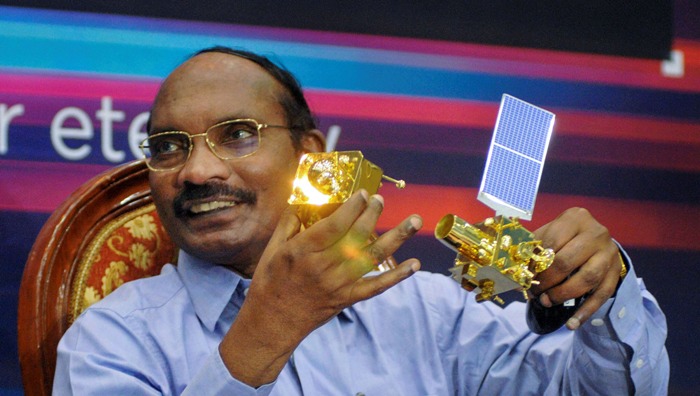
ISRO Chairman K Sivan displays a model of Chandrayaan 2 orbiter and rover during a press conference in Bengaluru, Tuesday, Aug. 20, 2019. A PTI Photo.
BENGALURU (PTI): India's Chandrayaan-2 mission, aimed at soft landing a rover in the unexplored south pole of the Moon, achieved a major milestone as the ISRO successfully injected the spacecraft into the lunar orbit on Tuesday.
"Today, the Chandrayaan-2 mission has achieved a major milestone. The precise lunar orbiter insertion manoeuvre was carried out at 9 am for about 30 minutes, precisely...
injected the Chandrayaan-2 in the designated orbit," Indian Space Research Organisation chief K Sivansaid here.
The insertion manoeuvre reduced the velocity of the Chandrayaan-2 from 2.4 km per second to 2.1 km per second, he added.
"For 30 minutes, our heart almost stopped," he told a press conference where he briefed about the crucial operation.
Chandrayaan-2, launched on July 22 by India's most powerful rocket GSLV MkIII-M1, had entered the Lunar Transfer Trajectory on August 14, leaving the Earth orbit. It comprises an Orbiter, Lander (Vikram) and Rover (Pragyaan).
The rover is set to make the soft landing on the Moon on September 7 and if successful the mission would make India the fourth country after Russia, the US and China to achieve the feat.
After Tuesday's exercise, the ISRO chief said the Chandrayaan-2 will go around the moon with an orbit of 140 km perigee (closest point) by 18,000 km apogee (farthest).
He added that four more manoeuvres will be carried out to achieve the perigee and apogee of 100 km X 100 km on September 1.
Giving an insight into the complexity involved, Sivan said there was a unique requirement for soft landing near the south pole of moon with an inclination of 90 degree, which no other missions in the past had ever achieved.
He said 'Vikram', the lander, will be separated from moon orbiter on September two.
From there onwards, the focus ofISRO will be towards the lander as all major operations willrevolved around the moon lander.
A small retro orbit manoeuvre of about three seconds will be carried out on September 3 and on the next day another similar exercise of 6.5 degree will be taken up to put the lander in an orbit of 35 km perigee and 97 km of apogee.
From September 4 onwards, various parameters would be checked to ensure that all the systems were perfectly alright, Sivan added.
"Next three days, we will be taking the various parameters of the lander to ensure that everything is right and to check and verify again and again, the system is perfectly alright", he said.
"On September 7 at 1.15 am the lander will be landing at a site 71 degree of moon's equator with 22.8 degree East", the ISRO chief said.
Underlining the significance of moon lander, Sivan said the landing will be a terrifying moment for him as well as theentire ISRO team given the challenges involved.
"Looking at what happened to the soft landing around the world, we are saying that the soft landing success rate is only about 27 per cent. But we have the confidence about our mission," Sivan said.
This is the second time that the ISRO has successfully carried out Lunar orbiter insertion.
Earlier in 2008, the Chandrayaan-1 spacecraft, India's first moon mission, was injected into the lunar orbit and it scripted history by making more than 3,400 orbits around the Moon.
The mission life of Chandrayaan-2 Orbiter would be one year, whereas that of the lander and rover would be one Lunar day, which is equal to 14 earth days.
According to ISRO, Chandrayaan 2 would shed light on a completely unexplored section of the Moon, its South Polar region where no other country has gone.
The Lander carries three scientific payloads to conduct surface and subsurface science experiments while the rover two payloads to enhance understanding of the lunar surface.













The Indian Air Force, in its flight trials evaluation report submitted before the Defence Ministry l..
view articleAn insight into the Medium Multi-Role Combat Aircraft competition...
view articleSky enthusiasts can now spot the International Space Station (ISS) commanded by Indian-American astr..
view article